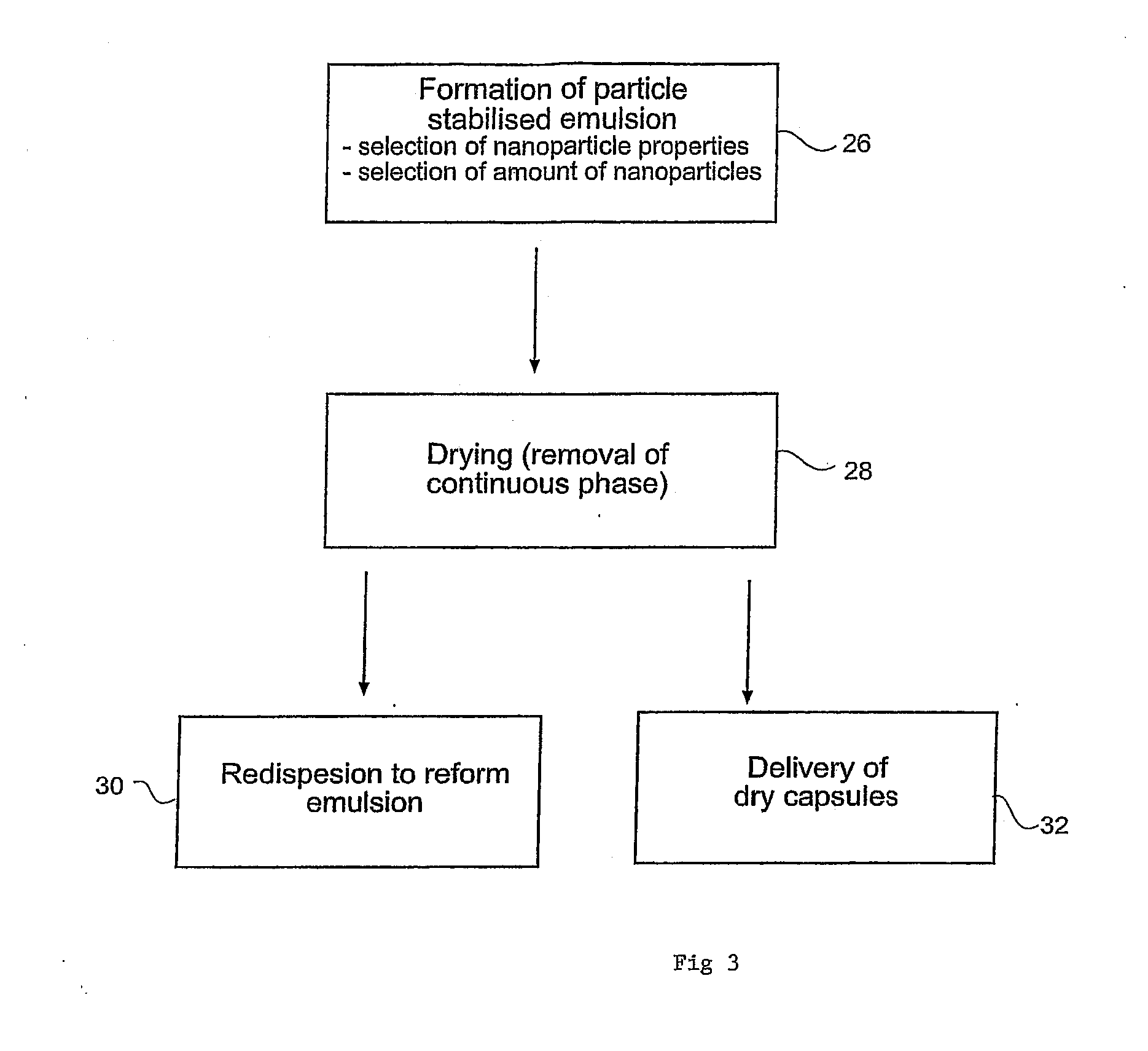Drug Release From Nanoparticle-Coated Capsules
a nanoparticle coating and capsule technology, applied in the field of capsules, can solve the problems of inability to formulate the active substance into a deliverable form, many emulsions and liposomes, and many potentially useful active substances that have not been commercialised, and achieve the effect of enhancing the control of releas
- Summary
- Abstract
- Description
- Claims
- Application Information
AI Technical Summary
Benefits of technology
Problems solved by technology
Method used
Image
Examples
example 1
Producing Nanoparticle-Stabilised Emulsion
a) Preparation and Characterisation of Emulsion Stabilised by Lecithin
[0132]Lecithin (0.6 g) stabiliser was dissolved in oil (Miglyol 812™) (10 g), and then added to water (total sample weight: 100 g) under mixing using a rotor-stator homogeniser (11,000 rpm, 10 minutes, pH=6.95±0.2). After 24 hours, the emulsion was characterised in terms of size (laser diffraction Malvern Mastersizer) and zeta potential (PALS). The droplet size ranges from 0.20-0.86 μm.
[0133]For the inclusion of an active substance, the active substance may be added to the oil before or after the addition of the lecithin.
b) Preparation of Nanoparticles
[0134]An aqueous dispersion of silica (Aerosil®) nanoparticles (1 wt %) was prepared by sonication over at least a one hour period. FIG. 5 shows that the average size of the silica nanoparticles was approximately 50 nm.
c) Capsule Formation
[0135]The emulsion formed in step (a) and the nanoparticle dispersion (b) were mixed tog...
example 2
Drying—Removal of Continuous Phase
[0138]The capsules formed in Example 1 were dried by rotary evaporation at 50° C., until the water phase was completely removed.
example 3
Preparation of Liquid PDMS Droplets
[0139]Aqueous solutions containing 1% diethoxy-dimethyl-silane (DEDMS), which was previously mixed with 0, 0.025, 0.1 and 0.25 wt % DBP in a nitrogen gas atmosphere, and 0.1% ammonia were sealed under nitrogen gas in a 250 ml reaction vessel, shaken vigorously for 30 seconds, and than tumbled at 30 rpm and 25° C. for 18 hours.
[0140]Drop size distributions were characterised by laser diffraction (Malvern Mastersizer X). Average drop sizes and size span [defined as (d(v,0.9)−d(v,0.1)) / d(v,0.5)] were ˜2 μm and 0.56 for the liquid droplets, and 1.55 μm and 1.2 for the cross-linked droplets. The presence of DBP did not significantly change the drop size distribution.
[0141]The emulsion samples were considerably more mono-dispersed than typical o / w or w / o emulsions prepared by homogenisation. Electrophoretic mobilities and hence ζ potentials were determined using a combination of microelectrophoresis (Rank Bross, Mark H) and PALS; ζ potentials are not cha...
PUM
| Property | Measurement | Unit |
|---|---|---|
| diameter | aaaaa | aaaaa |
| wt % | aaaaa | aaaaa |
| diameter | aaaaa | aaaaa |
Abstract
Description
Claims
Application Information
 Login to View More
Login to View More - R&D
- Intellectual Property
- Life Sciences
- Materials
- Tech Scout
- Unparalleled Data Quality
- Higher Quality Content
- 60% Fewer Hallucinations
Browse by: Latest US Patents, China's latest patents, Technical Efficacy Thesaurus, Application Domain, Technology Topic, Popular Technical Reports.
© 2025 PatSnap. All rights reserved.Legal|Privacy policy|Modern Slavery Act Transparency Statement|Sitemap|About US| Contact US: help@patsnap.com



